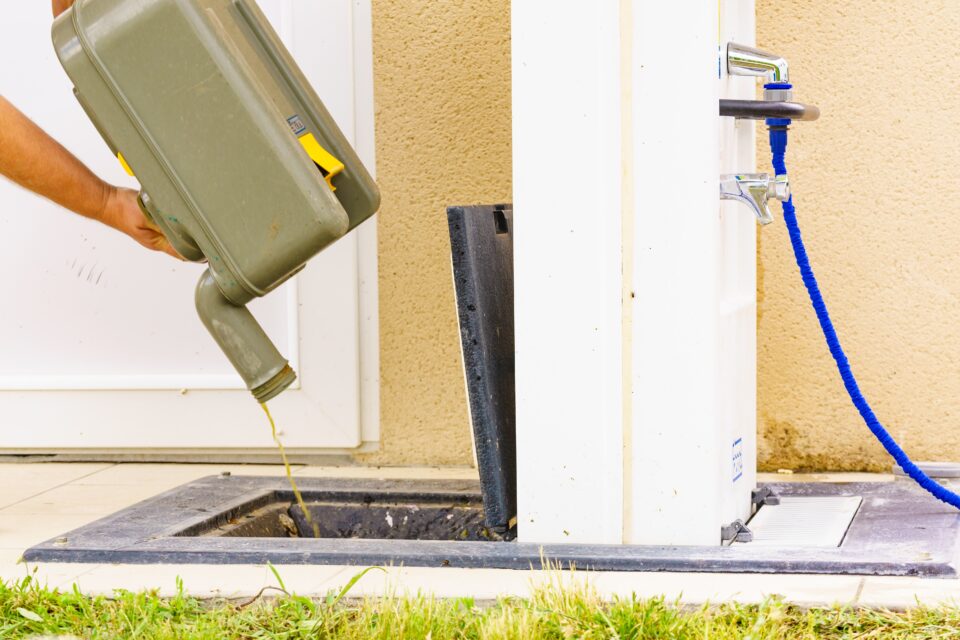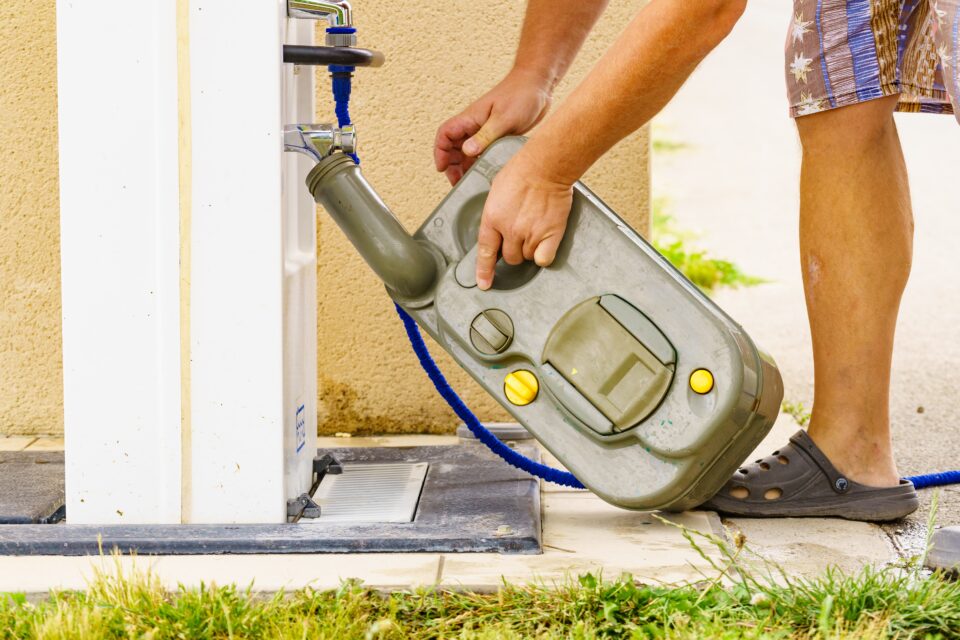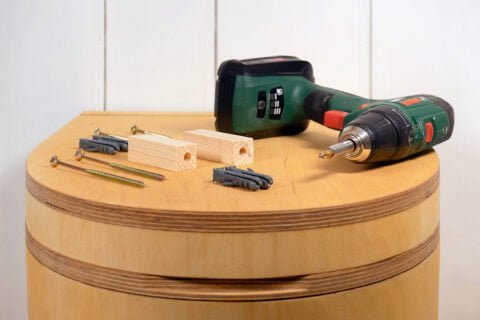TROBOLO TeraBlœm Plus
High-capacity wooden composting toilet with optional exhaust system as a complete kit.

In this guide, you will find information about the functionality, areas of application as well as the benefits and disadvantages of chemical toilets.
To this day, chemical toilets are still the best-known and most widely used alternative to a WC (water closet). For most people, the term ‘portaloo’ will certainly ring a bell. Anyone who’s ever been to a festival, similar major events or even the local town fair, has inevitably had an encounter with this type of well-known chemical toilet – and might not have the fondest memories of this.
However, this impression is probably based more on the overloading of these toilets at such events rather than on their general suitability.

In fact, due to the sanitary additives used, chemical toilets are not only relatively odourless (except for the inherent smell of the chemicals), they also do not require any water connection which has made them particularly popular in the world of camping.
On the other hand, the functionality of a chemical toilet with chemical additives delaying the decomposition of excretions also poses various and sometimes serious risks to humans and the environment. In the following article we will examine their principle, areas of application as well as further categories such as the cleaning and disposal of the wastewater.
A chemical toilet is characterised by the fact that it uses chemical substances which prevent and disinfect the bacterial decomposition processes of urine and faeces. The development of decay and odour processes is thus reduced or suspended. And while chemical toilets can be operated without any water connection, they cannot function entirely without water or the aforementioned chemical liquids which is why these toilets are not considered dry toilets. They are used mainly in the so-called ‘portaloos’ or fixed tank toilets, on-board toilets of transportation vehicles as well as in garden sheds and mobile homes. In the field of camping, they’re commonly known as ‘chemical cassette toilets’. Depending on the location of use, there are various chemical toilet designs available, from fixed to foldable and portable, with the mobility of chemical toilets certainly being one of their major advantages.
The fact that no water connection is required and the obvious advantage of odour prevention thanks to chemical substances assured the chemical toilet an undisputed top spot in the motorhome range for a long time. However, the use of chemistry also poses numerous risks. In general, the chemical sanitary additives have to be handled with great care as they not only endanger our health but also harm the ecosystem if they come into contact with it. Nowadays, there are also additives that are declared to be fully biodegradable, but even these are not entirely harmless to nature. A responsible approach to the use of these substances is therefore an absolute prerequisite.

Regardless of the model or location of use, chemical toilets are always based on the same principle. The solid and liquid excretions are collected together in a container to which chemical substances are added. These, as already mentioned, are to inhibit the natural bacterial decomposition of the droppings and thus prevent the development of unpleasant odours. At the same time, the chemicals act as disinfection and serve to accelerate the (chemical) decomposition of urine, faeces and the added toilet paper which makes the later emptying of the collecting container easier, if not necessarily pleasant.
Usually, chemicals such as glutaraldehyde and quaternary ammonium cations are used. These are all equally effective, predominantly because of their disinfecting effect, but, unfortunately, they’re also fraught with risk. Glutaraldehyde is characterised by a pungent odour and is furthermore highly toxic to both humans and aquatic organisms. Quaternary ammonium cations are also highly aggressive substances. The health risks arising from the use of said chemical sanitary additives are thus not to be underestimated in the slightest. There are indeed also substances that are declared fully biodegradable and are used in chemical toilets. However, the environmental sustainability of these agents does remain doubtful as the ingredients of the sanitary additives do not have to be precisely declared and an official licensing authority in the sense of a supervisory authority for chemical toilets does not exist. In any case, the chemical additives should be treated with extreme caution.
For more detailed information about the individual chemicals, the following links can be consulted:Glutaraldehyde: https://en.wikipedia.org/wiki/Glutaraldehyde
Ammonium compounds: https://en.wikipedia.org/wiki/Quaternary_ammonium_cation
Chemical toilets not only differ greatly from dry toilets in the way they work.
The accessories required and the disposal of waste and cleaning of the toilet also differ greatly from composting toilets.
Chemical toilets generally require very few accessories, and these are mainly limited to the chemical additives used. They are available in the form of tabs, powders or as liquids. The main difference between these lie in their respective usage. While tabs are easy to dose and can simply be added to the wastewater tank in one piece, the powders and liquids need to be measured carefully. When doing so, the manufacturer’s instructions should always be followed as an excessive amount of the substances doesn’t improve or enhance their effect. In addition to the chemical sanitary additives, some models may require small amounts of water for their flushing mechanism as well as electricity supply if they’re electrically operated. When using toilet paper, it’s important to ensure that it decomposes quickly. Special camping toilet paper can be acquired which meets these requirements.

Whilst chemical toilets with fixed tanks, such as the previously mentioned ‘portaloos’, are emptied by specialised companies, there is a lot to consider when emptying smaller models for private use.
Due to the strong antibacterial effect of the chemical additives, it is recommended to empty them via special disposal stations, which can be found at some service areas, campsites or sewage treatment plants, for example. Alternatively, the excreta from the chemical toilet could also be emptied via your own toilet at home. However, this is not very practical when travelling. There is also the risk that the chemical additives will damage your own toilet. As general rule, chemical toilets must not be emptied at public toilets.
Under no circumstances may the chemically treated waste be dumped into the environment since this will cause great damage and will accordingly be severely punished. How often the toilet should be emptied depends on several factors. The tank capacity, temperature, type of additives used and, of course, the frequency with which the toilet is used play a role here. In order to be able to consistently eliminate odours, it is recommended that the toilet is emptied daily and as regularly as possible. Special disposal stations usually charge for the emptying of a toilet, but in some places, this can also be done free of charge. Should you hire a chemical toilet with a fixed tank, i.e. a ‘portaloo’, the disposal costs are usually included in the hire price.

In order to maintain the functionality of the chemical toilet, it is also recommended to clean it after each emptying, partly because the components are additionally affected by the use of aggressive chemical substances. When cleaning the unit, you should use rubber gloves to avoid any unnecessary skin contact with the sanitary additives. The chemical toilet can be treated with normal household cleaning agents. The use of other chemical sanitary additives is not recommended as these can cause unwanted reactions.

Due to their waterless operation or more specifically, the independence of water supplies, chemical toilets are suitable for any location where water isn’t available. This means that chemical toilets with fixed tanks are predominantly used at construction sites, festivals or other major events. Smaller models, such as cassette toilets or portable models, are used particularly in the area of camping and are often standard equipment of motorhomes but can also be used in other areas such as garden houses or holiday homes, thanks to their compactness. What’s more, most models don’t require a power connection which further enhances autonomy and generally extends the areas of application. However, the circumstances that restrict an independent use of these toilets should be considered. Hence, the fact that the toilets should be emptied at specific disposal facilities inevitably prevents travel that extends beyond a few days.

Although chemical toilets do require small amounts of water, they do not need to be connected to the sewage system which is why they’re usually found in places that don’t have any water access. The chemical substances used then help to accelerate the chemical decomposition of excretions which, however, is fraught with risk in many respects. Below, these and other benefits and disadvantages are illustrated in a practical overview.
Sign up for our newsletter here to never miss out on any news or free promotions.

"Do-it-yourself" is the latest trend, so it's not surprising that more and more people want to build their composting toilet themselves. But how does that actually work? In this article, we take a closer look at the topic and give you numerous tips and tricks to make your do-it-yourself project a success. Have fun!
Read more
Below you will find information on functionality, areas of application as well as advantages and disadvantages of dry toilets.
Read more
In this guide, you will find information about the functionality, areas of application as well as the benefits and disadvantages of chemical toilets.
Read more¡Tenemos buenas noticias! Aunque gran parte de nuestro contenido todavía esté en inglés, ya hacemos envíos a tu país. Solo tienes que hacer el pedido y los productos te llegarán directamente a casa.
De acuerdoBuone notizie! Anche se la maggior parte dei nostri contenuti è ancora in inglese, spediamo già nel tuo paese. Fai un ordine e ricevi i prodotti direttamente a casa tua.
D'accordoVi har gode nyheder! Selvom det meste af vores indhold stadig er på engelsk, sender vi nu til dit land. Du skal bare afgive din ordre, så bliver produkterne leveret direkte hjem til dig.
ForståetWe hebben goed nieuws! Hoewel het meeste van onze inhoud nog steeds in het Engels is, verzenden we nu naar uw land. Plaats uw bestelling en de producten worden direct bij u thuisbezorgd.
BegrepenYou are currently viewing a placeholder content from Facebook. To access the actual content, click the button below. Please note that doing so will share data with third-party providers.
More Information